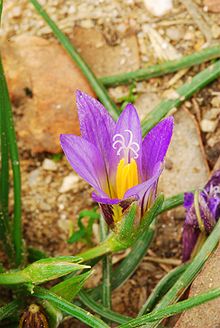
Crocus is a genus of seasonal flowering plants in the family Iridaceae comprising about 100 species of perennials growing from corms. They are low growing plants, whose flower stems remain underground, that bear relatively large white, yellow, orange or purple flowers and then become dormant after flowering. Many are cultivated for their flowers, appearing in autumn, winter, or spring. The flowers close at night and in overcast weather conditions. The crocus has been known throughout recorded history, mainly as the source of saffron. Saffron is obtained from the dried stigma of Crocus sativus, an autumn-blooming species. It is valued as a spice and dyestuff, and is one of the most expensive spices in the world. Iran is the center of saffron production. Crocuses are native to woodland, scrub, and meadows from sea level to alpine tundra from the Mediterranean, through North Africa, central and southern Europe, the islands of the Aegean, the Middle East and across Central Asia to Xinjiang in western China. Crocuses may be propagated from seed or from daughter cormels formed on the corm, that eventually produce mature plants. They arrived in Europe from Turkey in the 16th century and became valued as an ornamental flowering plant.

Dahlia is a genus of bushy, tuberous, herbaceous perennial plants native to Mexico and Central America. As a member of the Asteraceae family of dicotyledonous plants, its relatives include the sunflower, daisy, chrysanthemum, and zinnia. There are 49 species of dahlia, with flowers in almost every hue, with hybrids commonly grown as garden plants.

Colchicum is a genus of perennial flowering plants containing around 160 species which grow from bulb-like corms. It is a member of the botanical family Colchicaceae, and is native to West Asia, Europe, parts of the Mediterranean coast, down the East African coast to South Africa and the Western Cape. In this genus, the ovary of the flower is underground. As a consequence, the styles are extremely long in proportion, often more than 10 cm (4 in). All species in the genus are toxic.
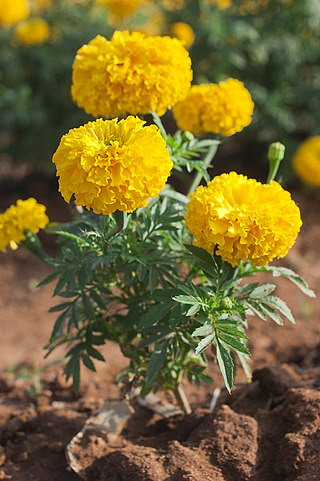
Tagetes is a genus of 50 species of annual or perennial, mostly herbaceous plants in the family Asteraceae. They are among several groups of plants known in English as marigolds. The genus Tagetes was described by Carl Linnaeus in 1753.

Iridaceae is a family of plants in order Asparagales, taking its name from the irises. It has a nearly global distribution, with 69 accepted genera with a total of c. 2500 species. It includes a number of economically important cultivated plants, such as species of Freesia, Gladiolus, and Crocus, as well as the crop saffron.
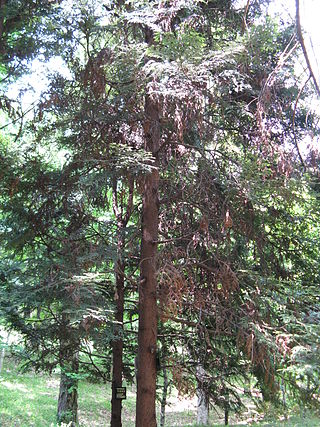
Thujopsis is a genus of conifers in the cypress family (Cupressaceae), the sole member of which is Thujopsis dolabrata. It is endemic to Japan, where it is named asunaro (あすなろ). It is similar to the closely related genus Thuja (arborvitae), differing in the broader, thicker leaves and thick cones.

Colchicaceae is a family of flowering plants that includes 15 genera with a total of about 285 known species according to Christenhusz and Byng in 2016.

Romulea is a genus of flowering plants in the family Iridaceae, first described as a genus in 1772. It is distributed in Europe, the Mediterranean, the Arabian Peninsula, and Africa.

Crocoideae is one of the major subfamilies in the family Iridaceae.
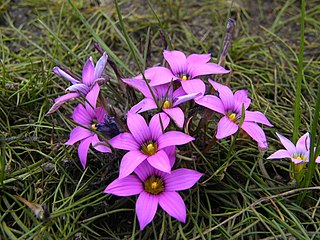
Romulea rosea is a herbaceous perennial plant in the family Iridaceae. It is a small plant, usually less than 20 cm high, with grass-like leaves. The flowers, which appear in spring, are pink with a yellow throat. Common names include Guildford grass, onion grass and rosy sandcrocus.

Ornamental bulbous plants, often called ornamental bulbs or just bulbs in gardening and horticulture, are herbaceous perennials grown for ornamental purposes, which have underground or near ground storage organs. Botanists distinguish between true bulbs, corms, rhizomes, tubers and tuberous roots, any of which may be termed "bulbs" in horticulture. Bulb species usually lose their upper parts during adverse conditions such as summer drought and heat or winter cold. The bulb's storage organs contain moisture and nutrients that are used to survive these adverse conditions in a dormant state. When conditions become favourable the reserves sustain a new growth cycle. In addition, bulbs permit vegetative or asexual multiplication in these species. Ornamental bulbs are used in parks and gardens and as cut flowers.

Garden roses are predominantly hybrid roses that are grown as ornamental plants in private or public gardens. They are one of the most popular and widely cultivated groups of flowering plants, especially in temperate climates. An enormous number of garden cultivars have been produced, especially over the last two centuries, though roses have been known in the garden for millennia beforehand. While most garden roses are grown for their flowers, often in dedicated rose gardens, some are also valued for other reasons, such as having ornamental fruit, providing ground cover, or for hedging.

Colchicum bulbocodium, the spring meadow saffron, is a species of alpine bulbous plant native to mountain ranges across Europe from the Pyrenees to the Caucasus.

Chrysanthemum × morifolium is a hybrid species of perennial plant in the genus Chrysanthemum of the Asteraceae family.

Narcissus bulbocodium, the petticoat daffodil or hoop-petticoat daffodil, is a species of flowering plant in the family Amaryllidaceae, native to southern and western France, Portugal, and Spain. Some sources say that the species is also native to Morocco, but this is based on populations formerly thought to be varieties of N. bulbocodium but now regarded as separate species.

Romulea sabulosa is a perennial geophyte that is assigned to the family Iridaceae. It has a few grooved thread-like leaves, and relatively large burgundy red trimerous flowers, reminiscent of crocus flowers, with yellow to light greenish with black markings and stamens with light green free filaments. It only occurs on sandy clay on renosterveld west of Nieuwoudtville in the Northern Cape province South Africa. It is called satynblom in Afrikaans.

Romulea tortuosa is a herbaceous perennial geophyte in the family Iridaceae native to South Africa. It has a small corm in the soil, a few prostrate coiling leaves, and fragrant, trimerous yellow flowers, sometimes with six brown blotches on the inside near the bottom of the flower.
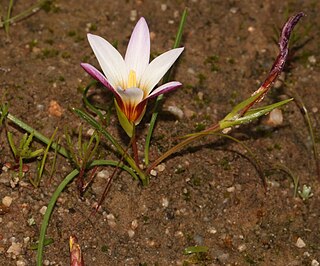
Romulea toximontana is low a herbaceous perennial geophyte in the family Iridaceae native to South Africa. It has a small corm in the soil, several linear leaves, white trimerous flowers, yolk-yellow near the centre and with a purple wash on the outside. The 1997 IUCN Red List of Threatened Plants lists this species as rare.

Romulea monadelpha is a herbaceous perennial geophyte in the family Iridaceae native to South Africa. It has a small corm in the soil, a few thread-like leaves, and trimerous dark red flowers with elaborate markings on the inside near the bottom of the flower. It is called karoo satynblom in Afrikaans.

Romulea columnae, the sand crocus, is a herbaceous perennial in the family Iridaceae. It is a small plant, with thin narrow leaves, and small scape which has small pink, pale purple or violet pointed flowers with darker veining and a gold or yellow throat. It is native to a wide area ranging from western Europe to the Mediterranean.
